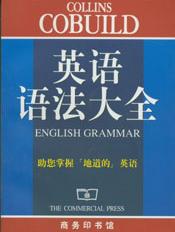牛津实用英语语法-第64章
按键盘上方向键 ← 或 → 可快速上下翻页,按键盘上的 Enter 键可回到本书目录页,按键盘上方向键 ↑ 可回到本页顶部!
————未阅读完?加入书签已便下次继续阅读!
你不需要/将不需要说什么。
I dared not wake him.
我不敢叫醒他。
但是说:
I didn’ t/wouldn’ t dare(to) wake him.
我没敢/不敢叫醒他。
理论上,在最后一个例句中要求用to,但实际上常被省略。按语法规则来说,如果dare和used用为助动词,它们就像大多数助动词一样后面接不带to的不定式;如果它们用为普通动词并与do/ did等连用,就像普通动词一样后面接带to的不定式。
C feel, hear, see和 watch:
I heard him lock the door.
我听见他锁了门。
I saw/watched him drive off.
我看见他开车走了。
但see和hear在被动语态的句子中要与带to的不定式连用:
He was seen to enter the office.
有人看见他进了办公室。
He was heard to say that…
有人听见他说过……
但feel,hear,see和watch经常是与现在分词连用:
I heard them shouting.
我听到他们在大声喊叫。(参见第273节。)
D let在主动语态和被动语态的句子中都与不带to的不定式连用。但let在被动语态的句子中常常被另一个词所代替: Theylet me know… 在被动词态的句子中被 I was told… 所代替,而 They let him see the documents则被 He was allowed to see them所代替。
let之后的不定式/不定式短语有时为了避免重复而被省略:
She wants to go out to work but he won’t let her(go out to work).
她想要出去工作,可他不让她去。
在下面的习语中,let没有宾语:
Live and let live.
宽己容人。
(关于 let us/let’s 用于表示命令和建议,参见第281节与第289节。)
E make
make 在主动语态的句子中与不带to的不定式连用:
He made me move my car.
他迫使我挪动我的汽车。
但在被动语态的句子中make与带to的不定式连用:
I was made to move my car.
我被迫挪动了我的汽车。
为了避免重复,有时make(主动语态)之后的不定式可省去:
—Why did you tell him?
—He made me(tell him)!
—你为什么要告诉他?
—是他迫使我(告诉他)的!
make(被动语态)之后的不定式可由to来代表:
I was made to(tell him).
我是被迫(告诉他)的。
F would rather/sooner, rather/sooner than(参见第297与第298书):
—Shall we go today?
—I’d rather wait till tomorrow.
—我们今天去好吗?
—我宁可等到明天再去。
Rather/Sooner than risk a bad crossing, he postponed his journey.
他不愿冒大风险,推迟了横渡海峡的旅行。
G had better(参见第120节):
‘You had better start at once,’he said.
他说:“你最好马上就动身。”
H help后面接带to或不带to的不定式都可以:
He helped us(to) push it.
他帮我们推它。
I 如果两个不定式由and连接在一起,通常可将第二个不定式的to省略:
I intend to sit in the garden and write letters.
我打算坐在花园里并写些信。
I want you to stand beside me and hold the torch.
我要你站在我身边拿着手电筒。
J but 和 except跟在 do+ anything/nothing/everything后面时,可以与不带to的不定式连用:
He does nothing but plain.
他只是一个劲地抱怨。
My dog does everything but speak.
我的狗除了不会说话以外什么都会。
Can’t you do anything but ask silly questions?
你别一个劲地提愚蠢的问题好吗?(你除了提愚蠢的问题,难道不会干点别的?)
There’s nothing to do but wait.
除了等候没有别的办法。
K 在下列句子中to可有可无:
The only thing to do/we can do is(to) write to him.
唯一可做的事/我们唯一能做的事是给他写信。
All we can do is(to) write to him.
(译文同上。)
?
'Amber demo'
247 用to代表的不定式
?
为了避免重复,不定式可只用一个to来代表。这种用法主要用于下列动词之后: hate, hope, intend, would like/love,make(被动语态),mean, plan, try, want;也用于助动词如have, need, ought之后时以及与 used to, be able to和 be go-ing to结构连用时:
—Would you like to e with me?
—Yes, I’d love to.
—你愿意和我一起走吗?
—是的,我愿意。
—Did you get a ticket?
—No, I tried to, but there weren’t any left.—你有票了吗?
—没有,我尽力找了,可一张也没有了。
—Why did you take a taxi?
—I had to(take one).I was late.
—你为什么坐出租汽车?
—我不得不坐。(因为)我晚了。
—Do you ride?
—Not now but I used to.
—你骑马吗?
—我现在不骑了,但以前骑。
He wanted to go but he wasn’t able to.
他想去,但去不了。
—Have you fed the dog?
—No, but I’m just going to.
—你喂过狗了吗?
—没有,我这就要去呢。
?
'Amber demo'
248 分裂不定式
?
在to和动词原形之间插入另一个词,称为分裂不定式。这种用法过去常被认为是文字不通顺,但现在人们对它的看法比较宽容了。
在日常口语中really常常接在to之后而位于动词原形之前。
It would take ages to really master this subject.
这门学科需要许多年才能真正掌握。
这个地方如用 really to master,反而显得过分正式。
其他一些程度副词如pletely,entirely,(un)duly也可同样使用。可以说:
(a) to pletely cover the floor完全铺满地板
而不说:
(b) to cover the floor pletely
(a) to unduly alarm people过分使人们惊惶
而不说:
(b) to alarm people unduly
但按照惯例,如上面(b)所示则较为安全。
?
'Amber demo'
249 可起连词作用的不定式
?
A 不定式用在only后面时,常表示一种令人失望的后果:
He hurried to the house only to find that it was empty.
他急忙赶到那所房子,却发现空无一人。相当于:
He hurried to the house and was disappointed when he found that it was empty.
他急忙赶到那所房子,但发现房子空无一人时感到大为失望。
he survived the crash only to die in the desert.相当于:
He survived the crash but died in the desert.
飞机坠毁时他幸免于难,后来却死在沙漠里。
B 不定式前不加 only也可以起连接作用,并且不带有不幸的含义:
He returned home to learn that his daughter had just bee engaged.
他回到家里,得知女儿才订了婚。
但这类用法主要限于如 find, hear, learn,see, be told这类动词,否则用于起连接作用的不定式就可能被错认为是表示目的的不定式。
?
'Amber demo'
250 可替代关系从句的不定式
?
A 不定式可用于 the first, the second等如此类推及 the last, theonly之后,有时也可用于最高级之后(参见第77节):
He loves parties; he is always the first to e and the last to leave.
他喜欢参加社交聚会,总是头一个来,最后一个走。
She was the only one to survive the crash.
她是这次事故中唯一的幸存者。
这样使用的不定式代替了主格代词+动词结构。下面B中将它与不定式代替宾格代词+动词结构进行了比较。
注意这里不定式的含义是主动的。如果需要被动的含义则用不定式的被动式:
He is the second man to be killed in this way.
他是第二个这样死于非命的人。
the best play to be performed that year那年演出的最精彩的戏
试与下面短语比较:
the best play to perform 一出最适合/最应当由你演出的戏
B1 不定式可以放在名词和代词后面以表示可以怎么使用或处置它们,有时也可表示主语的愿望(参见第77节):
I have letters to write.
我有信要写。
Does he get enough to eat?
他吃得饱吗?
Have you anything to say?
你有话要说吗?
At the customs: I have nothing to declare.
在海关检查站:我没有要报关的。
a house to let待出租的房子
不定式+介词结构也可以这样使用:
someone to talk to可与交谈的人
a case to keep my records in放我的磁带的盒子
cushions to sit on 坐垫
a glass to drink out of 喝水杯
a tool to open it with用来打开这东西的工具
a table to write on写字台
2 不定式被动式的类似用法
There is plenty to do.
(a)有不少事情可做。即可供自娱的事。
(b)有不少工作必须做。
there+ be+名词/代词+不定式结构如有“义务”的含义,如上面(b)所示,则可用不定式的被动形式:
There is a lot to be done.
有大量的事要做。
但不定式的主动形式用得更多。
?
'Amber demo'
251 某些特定的名词之后的不定式
?
常用的可以直接跟不定式的名词有:
ability牋牋牋牋牋 demand牋牋牋牋牋牋 failure牋牋牋牋牋牋 request
ambition牋牋牋 desire牋牋牋牋牋牋牋?offer牋牋牋牋牋牋牋 scheme
anxiety牋牋牋牋 determination牋牋 plan牋牋牋牋牋牋牋?willingness






